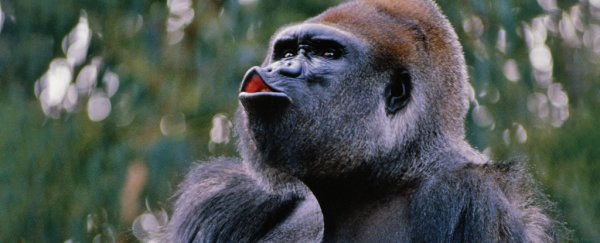In a fascinating discovery, western lowland gorillas (Gorilla gorilla gorilla) at Zoo Atlanta have been caught summoning their keepers using a strange cough-sneeze hybrid.
Only two other species have displayed this ability to create new vocalizations to attract our attention: zoo-housed chimpanzees and orangutans. Now, we can add gorillas to that list.
Below, 24-year-old female gorilla Sukari demonstrates this gorilla equivalent to a human 'ahem' which researchers have called a 'snough'.
As many of us know, Koko put a spotlight on gorilla intelligence in the '80s and '90s with her incredible ability to communicate with humans using sign language. She was trained and worked diligently at it, but now it seems gorillas have taken it upon themselves to establish unique communication with us on their own terms.
University of Georgia biological anthropologist Roberta Salmi and colleagues, ran an experiment to confirm the purpose of the 'snough', by placing eight of the zoo's gorillas in three different situations.
In the first, only the keeper was present; in the second only the food was present; and in the final one, the keeper was holding the food. The food and keeper when present were in sight but out of reach.
The gorillas involved used the ahem-like 'snough' vocalization most when there was a human present with food, indicating the call is likely an attempt to get the keeper's attention.
Interestingly, the same call has been found in other US zoos too. As many as 33 gorillas housed at 11 different zoos across the US and Canada, are reported to make a similar call, although only six gorillas in four different facilities have been confirmed using the sound so far.
Salmi and team aren't sure if different groups have worked out independently that this sound is effective, or if it has spread through the clever primates (who are more than capable of learning from each other) passing on their knowledge to each other.
Most components of language do emerge in the communications systems of other animals, like vocal learning, syntax and semantics. Non-human primates were once thought to lack the right equipment to vocalize the way we do, but this has since been shown to be untrue.
We share similar vocal muscles as well as our shared evolutionary history. Whatever precludes them from advanced vocal mimicry has seen them dismissed as 'non-vocal' learners.
The gorillas were never caught using the 'snough' to communicate with each other. The novelty of this call adds to a growing body of evidence that primates can indeed make new sounds for new contexts and therefore are vocal learners.
"Evidence of vocal learning and/or innovation, although scant, is slowly accumulating for captive apes," the team wrote in their paper.
"Orangutans can learn to produce voiced utterances and whistles, chimpanzees adopt new referential food calls through vocal convergence under social integration, and enculturated apes, such as the gorilla Koko and the chimpanzee Vicky, are able to produce a limited number of novel utterances."
Previous research has also shown gorillas can recognize and distinguish between the voices of different humans.
Examples of complex vocal learning – the ability to produce unique calls – are rare in the animal kingdom and confirmed only in some species of birds, bats, pinnipeds, cetaceans and elephants. But they all do so by mimicking.
Acoustic analysis showed the gorilla's snough is a unique sound, not a mimic - although these cheeky apes are certainly capable of mimicking us in other ways.
"These results demonstrate that gorillas can modify their calls to produce a novel sound and furthermore confirm that they can produce their calls and gestures intentionally to modify the attention status of their caregiver," the team concluded in their paper.
We've clearly long underestimated these clever souls.
This research was published in PLOS One.
